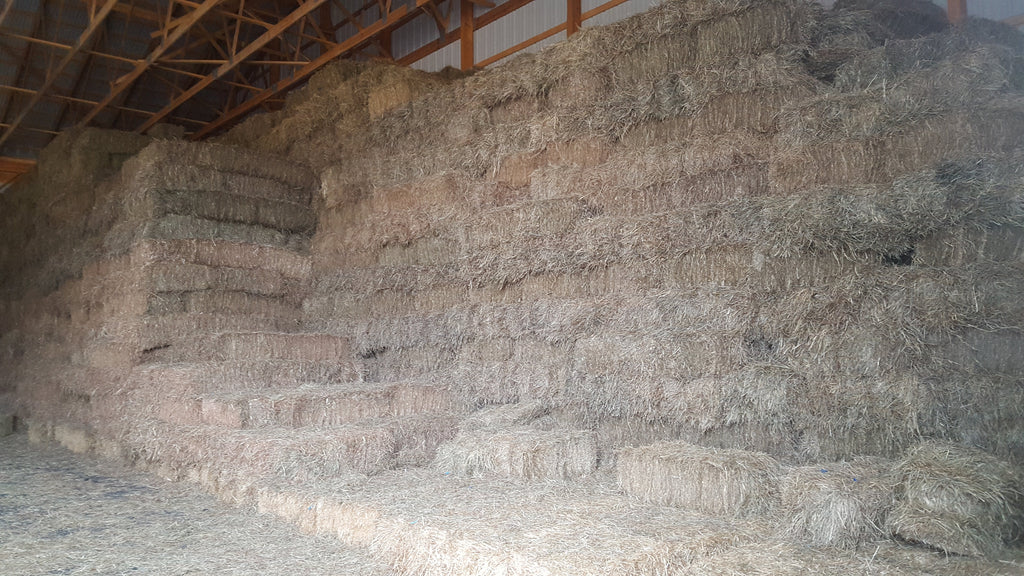
My sheep were disappointed with the hay I bought this fall. One of my neighbors had recommended the farm to me, and I called to order 70 bales. I was busy getting ready for Rhinebeck, so I didn't go look at it myself. As it was being unloaded into my hay storage, I wasn’t thrilled, but I didn’t want to complain. The sheep had no interest in it, and I thought maybe it was because there was still pasture. But even after 2 months, my sheep still wouldn't eat the hay. I grew increasingly worried about the coming winter, and having good nutrition for the ewes I want to breed.
 Disappointing hay
Disappointing hay
So what was wrong with the hay I bought? At Rhinebeck this year, instead of checking out the sheep, I was more interested in nosing around everyone's hay. And I saw bales of soft, green, leafy blades that I coveted more than a flock of Valais Blacknose lambs. My hay was mostly tough, dry, yellow stalks. It wasn't the worst hay I've had--that would have been the bales I bought the first year, which were full of weeds that are toxic to sheep, like milkweed and skunk cabbage, and thorny plants like wild rose and thistle. Horsenettle is the worst, with its poisonous berries and brittle, thorny leaves that are impossible to remove from the hay without shattering. One of my fields is full of it, so I see plenty of it in the summer. My girls know to stay away from it in the field, but when it's packed into a bale of hay, it's hard to escape the thorns.
 Horsenettle (Solanum carolinense)
Horsenettle (Solanum carolinense)
With encouragement from my local shepherding community, I took a deep breath and called the hay guy. It was an uncomfortable conversation, but he was reasonable and he agreed to pick up all the hay. He also brought over some bales of first-cut hay, but it's less ideal nutritionally, and didn't look any more appetizing. It was such a relief to get that over and done with, but I still had to find another source this late in the year.
People buy their winter hay in September or October, so by now, most hay farmers only have bales of the less nutritious 1st cutting left. And it goes up in price, too. I went back to the hay farm where I bought my hay last year. I hadn’t gone back to him because I’d found a lot of stalks and poisonous weeds, but when I look back at pictures of that hay from last year, it looks wonderful compared to what I got this year. I drove to his his hay barn, to see what his bales looked like this year. Some bales looked terrific, and some bales looked as bad as the ones I had bought this year.
 Tasty-looking top layer
Tasty-looking top layer
The hay farmers in the area bale hay for several different fields, which accounts for the variety of hay in the barn. And I’m told that the hay can vary even within a field. I could see how one person’s testimony about her terrific hay could result in me receiving sub-par hay. The hay farmer was still baling hay in the fields, so I just left him a check and bought some sample bales from different locations in the barn, to see what the sheep would like.
One of the bales was a beautiful green, but the grass was really fine. It was probably orchard grass, which the sheep enjoy but doesn’t work with my feeders. After a few bites, most of the hay ended up falling through the feeder and my sheep have this adorable little quirk where even though THEY EAT GRASS THAT GROWS IN THE GROUND, they will never, ever eat hay that’s touched the floor of the barn...even if it lands on top of a pile of perfectly clean hay.
 From left to right: green but too-fine orchard grass, the winner, the sample
From left to right: green but too-fine orchard grass, the winner, the sample of first cutting, and the hay I ended up returning.
The second sample bale was a winner. I was as excited as the sheep were when I opened it and saw the nice, wide, green blades. I couldn't wait to order a winter's supply of this hay. Since I wanted to show him which bales I wanted, I needed to meet him at his barn. He was still harvesting fields, so it took a few weeks for him to find a time. In the meantime, I made another trip to pick up a few bales in my car. There was another setback when I got there--the hay that we had our hearts set on had become buried behind 200 bales of yellow, unappetizing hay. Was I supposed to ask him to move all those bales out of the way so I could get the hay I wanted for my sheep? When he was finally able to meet me, I saw that he had sold those other bales, leaving easy access to the nice bales. I was pretty excited to watch him load my onto the truck. Isn't hay machinery wild? This thing has rollers that enable it to pick up 10 bales of hay at a time.

And here it is, all stacked in the storage for winter. It's such a difference, and a huge relief. The bales had gone up by $1/bale since October, but I feel lucky I found any at all. The hay farmer told me that he'd even heard of 2nd cut selling for $20/bale, which sounds incredible, but who knows how desperate I would have become in another month?

Lessons I'll put into practice next year:
- Buy hay early. There's no getting around needing hay. I always dream that a brand new and wonderful hay farm is going to magically appear on the scene between August and October, but I have to admit that sounds pretty unrealistic. I'll buy what's available, as soon as it's available.
- Always go look at the hay, and confirm which hay will be delivered.
- Don’t wait to speak up if it doesn’t look right.

Comments on post (1)
Natalie Kitterman says:
Hey, Natalie from Social Buzzzy here. I’ve found a breakthrough for Instagram engagement and had to share it with you!
Social Growth Engine offers an extraordinary tool that boosts Instagram engagement. It’s simple:
- Focus on producing amazing content.
- Economical at just below $36/month.
- Reliable, efficient, and perfect for Instagram.
Witnessing amazing results, and I know you will too! Elevate your Instagram game now: http://get.socialbuzzzy.com/instagram_booster
Cheers your success,
Your friend Natalie
Leave a comment